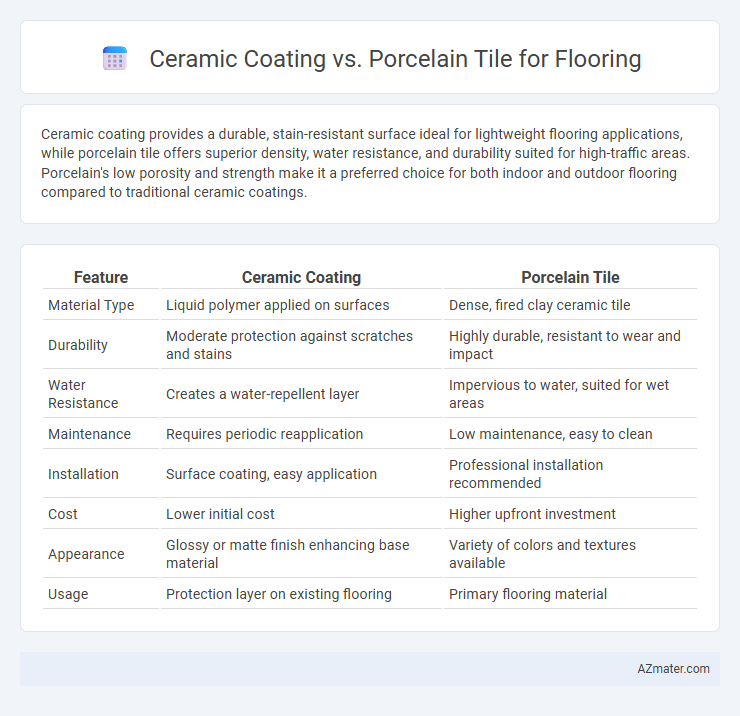Ceramic coating provides a durable, stain-resistant surface ideal for lightweight flooring applications, while porcelain tile offers superior density, water resistance, and durability suited for high-traffic areas. Porcelain's low porosity and strength make it a preferred choice for both indoor and outdoor flooring compared to traditional ceramic coatings.
Table of Comparison
| Feature | Ceramic Coating | Porcelain Tile |
|---|---|---|
| Material Type | Liquid polymer applied on surfaces | Dense, fired clay ceramic tile |
| Durability | Moderate protection against scratches and stains | Highly durable, resistant to wear and impact |
| Water Resistance | Creates a water-repellent layer | Impervious to water, suited for wet areas |
| Maintenance | Requires periodic reapplication | Low maintenance, easy to clean |
| Installation | Surface coating, easy application | Professional installation recommended |
| Cost | Lower initial cost | Higher upfront investment |
| Appearance | Glossy or matte finish enhancing base material | Variety of colors and textures available |
| Usage | Protection layer on existing flooring | Primary flooring material |
Introduction to Ceramic Coating and Porcelain Tile Flooring
Ceramic coating provides a protective layer that enhances floor durability and stain resistance, commonly applied on various surfaces for long-lasting upkeep. Porcelain tile flooring, made from highly dense clay fired at elevated temperatures, offers exceptional hardness, water resistance, and a sleek, polished appearance suitable for high-traffic areas. Both options deliver practical benefits in flooring maintenance, but porcelain tile provides a more permanent, structural solution compared to the surface-level protection of ceramic coatings.
Material Composition and Manufacturing Process
Ceramic coating involves applying a liquid polymer that chemically bonds to surfaces, creating a durable, protective layer primarily composed of silica and titanium dioxide, enhancing scratch and stain resistance. Porcelain tile is manufactured from a refined clay mixture fired at higher temperatures, resulting in a denser, less porous material with exceptional strength and water resistance. The manufacturing process of porcelain tiles includes firing at temperatures above 1200degC, while ceramic coatings are cured at lower temperatures to form a hard, transparent layer, distinguishing their functional properties in flooring applications.
Durability and Longevity Comparison
Ceramic coating enhances surfaces by providing a protective layer that resists scratches and stains, extending the lifespan of existing flooring materials, while porcelain tile offers inherent durability due to its dense, vitrified composition, making it highly resistant to wear and moisture. Porcelain tiles typically last 50 years or more with minimal maintenance, whereas the longevity of ceramic coatings depends on application quality and surface conditions, generally requiring reapplication every 2 to 5 years. For high-traffic areas, porcelain tile's superior hardness and moisture resistance make it a more enduring flooring choice compared to ceramic coatings used as surface protection.
Aesthetic Appeal and Design Options
Ceramic coating offers a glossy, smooth finish available in diverse colors and patterns, enabling tailored aesthetic appeal for various interior styles. Porcelain tile provides a denser, more refined surface with intricate designs and mimics natural stone or wood textures, enhancing sophisticated visual depth. Both options deliver durable, low-maintenance solutions, but porcelain's higher density allows for more detailed and high-end design versatility.
Installation Process and Requirements
Ceramic coating requires a clean, smooth surface and can be applied directly to existing floors, offering a quick installation with minimal preparation. Porcelain tile installation involves precise subfloor leveling, mortar application, and grout setting, requiring skilled labor and more time. Ceramic coating offers a less labor-intensive, faster process, while porcelain tile installation demands higher expertise and careful preparation.
Maintenance and Cleaning Differences
Ceramic coating on floors provides a durable, stain-resistant surface that requires minimal maintenance, typically involving regular sweeping and occasional mopping with mild cleaners. Porcelain tile offers a denser, less porous finish, making it more resistant to moisture and easier to clean grime without special treatments. Both materials benefit from routine care, but porcelain tile generally demands less frequent sealing and is more resistant to scratches and stains compared to ceramic-coated floors.
Resistance to Stains, Scratches, and Moisture
Ceramic coating offers strong resistance to stains and moisture due to its dense, non-porous surface, making it easier to maintain in high-traffic areas. Porcelain tile excels in scratch resistance thanks to its high density and hardness, providing a durable flooring option ideal for both residential and commercial spaces. Both materials resist moisture effectively, but porcelain's lower water absorption rate makes it particularly suitable for wet environments like bathrooms and kitchens.
Cost Analysis: Upfront and Long-Term Expenses
Ceramic coating generally offers a lower upfront cost compared to porcelain tile, making it a budget-friendly option for flooring. However, porcelain tile provides greater durability and resistance to wear, reducing long-term maintenance and replacement expenses. Factoring in potential repair costs and lifespan, porcelain tile often proves more cost-effective over extended periods despite its higher initial investment.
Environmental Impact and Sustainability
Ceramic coating for flooring offers a durable, low-maintenance surface that reduces the need for frequent replacements, thereby minimizing waste and resource consumption. Porcelain tile, made from denser clay and fired at higher temperatures, typically has a longer lifespan and greater resistance to wear, contributing to sustainability through extended use and recyclability at the end of its life cycle. Both materials have relatively low environmental impact compared to synthetic flooring options, but porcelain's longevity and natural composition often make it a more sustainable choice for eco-conscious building projects.
Best Applications and Suitability for Different Spaces
Ceramic coating is ideal for high-traffic residential areas and commercial spaces due to its durability, stain resistance, and ease of maintenance, making it suitable for kitchens, bathrooms, and living rooms. Porcelain tile offers superior moisture resistance and strength, making it the best choice for outdoor patios, entryways, and wet areas like showers and pool surrounds. Both materials provide aesthetic versatility, but porcelain's denser composition makes it more suitable for heavy-duty applications and environments exposed to harsh conditions.

Infographic: Ceramic coating vs Porcelain tile for Flooring
 azmater.com
azmater.com